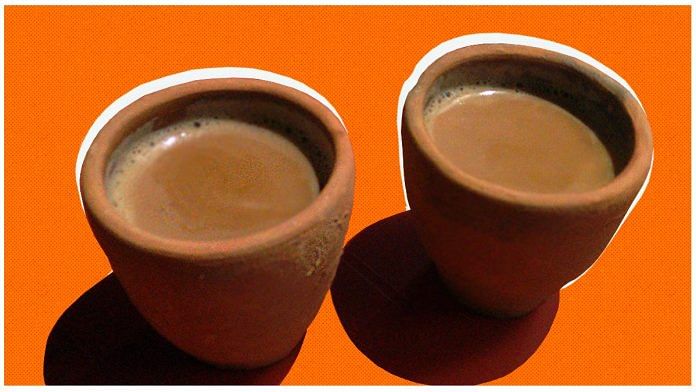New Delhi: After Prime Minister Narendra Modi’s announcement that India will phase out single-use plastics starting 2 October, Union Road Transport and MSME Minister Nitin Gadkari has revived the idea of using ‘kulhads’ (earthen cups) to serve tea at railway stations.
The proposal has been sent to Railway Minister Piyush Goyal.
The idea is hardly a new one, though. Many previous railway ministers have proposed replacing plastic cups with traditional kulhads. In 2004, then-railway minister Lalu Prasad had issued an order to start serving hot beverages in kulhads to boost potters’ income and switch to a ‘greener’ alternative.
However, there are doubts about whether the plan is as environment-friendly as widely believed.
Also read: 5 facts that support Modi’s move to ban single-use plastic in India
Carbon footprint of kulhads
Kulhads are said to be biodegradable. They are made using mud, and ultimately find their way back into the soil.
However, years of scientific dialogue on environmental policies has taught us that biodegradability is not the only parameter to gauge whether an item is eco-friendly.
Carbon footprint — defined as the green-house emissions released into the atmosphere by any human activity — is an environmental cost that is rarely talked about.
The carbon footprint of single-use plastics is about 6 kg, meaning for every one kilogram of plastic produced, six kilograms of carbon dioxide is emitted. So far, there is no ready estimate of the carbon footprint of making a kulhad.
To calculate it, one has to estimate the emissions from the fuel burned in transporting the clay, as well transporting the finished goods to railway stations, explained Indraneel Ghosh, a scientist who works on soil protection at Germany’s Deutsche Gesellschaft für Internationale Zusammenarbeit GmbH (GIZ), an international development agency headquartered in Bonn.
Then, there are emissions from the baking process. Brick kilns are the largest users of coal in India after thermal power plants and the iron and steel industry. They produce a third of the carbon emissions from the industrial sector. Terracotta items are also baked in such furnaces.
The third factor is the organic matter stored in clay, which when burnt, returns sequestered carbon back into the air.
“However, organic carbon is a much smaller component of the overall carbon footprint of producing terracotta,” said Ghosh.
The carbon footprint of producing one kilogram of bricks in India is estimated to be about 195 grams. The process of making kulhads is similar, but it has an additional component of electricity used to run modern pottery machines.
While the carbon footprint of plastic is much higher, the weight of a kulhad is more than that of a plastic cup, which means there are fewer kulhads per kg than plastic cups.
Also read: Banning single-use plastic bags won’t save our oceans
Soil quality degraded
Carbon footprint is not the only environmental impact of kulhads. The type of soil used to create earthenware also happens to be among the most fertile types of soil, said Sanjay Dhale, scientist at the Soil and Land Use Survey of India.
The organic carbon content, which is what makes the soil fertile, gets removed during the process of baking. Thus, even if the terracotta ultimately ends up in the soil, the overall quality is degraded.
Land and soil are limited resources, while the Indian Railways has over 23 million daily passengers, and the number keeps increasing.
“About one kilogram of clay is required to make up to 60 small kulhads,” said Dr Shankar Ram, an assistant field officer in the Soil and Land Use Survey of India whose family is in the pottery business.
If even a third of the passengers sip some ‘kulhad wali chai’, 117 tonnes of fertile soil will be displaced and degraded on a daily basis. Moreover, terracotta can take decades to degrade. Unless the disposed kulhads are reused, the cups will continue to add to landfills.
On the other hand, single-use plastics have a very high footprint and take centuries to degrade. While there is an urgent need to phase them out, it would be prudent to assess the overall environmental impact before considering an item as ‘eco-friendly’, experts said.
Also read: Modi govt’s blanket ban on plastics at this moment of economic slowdown is a bad idea




Is there any way to mimic fertile soil without disturbing our farming ?
Look first thing kulhads are still being made everyday in our country. So to say that to produce kulhadi there will be extra environmental cost is baseless as it is being incurred today also & remember while using kulhadi will also reduce the equivalent amount of plastic environmental cost.
So net environmental cost will be way less than you expect.
Secondly, No technology can make the plastics degradable but the technology can surely help in making kulhadi more degradable and environmental friendly.
We should stop using plastic immediately use available options and then think to use more eco friendly alternatives.
Modern ways of making kulhad can be found. Infact we just need to use renewable ways of making them, which can be done today. On the other hand, there is no eco-friendly way possible for plastic cups.
All Liquids (especially hot) poured in Plastic cups causes release of Pthalates into your tea or water or any beverage – a toxin equally deadly for Author of article, Research Scientists, Readers of this article. Information is freely available online regarding this.
https://m.wikihow.com/Avoid-Phthalates
Article should include such information like above and help their readers take an informed decision.